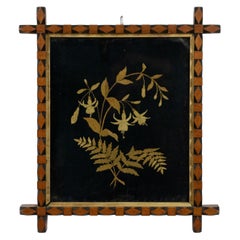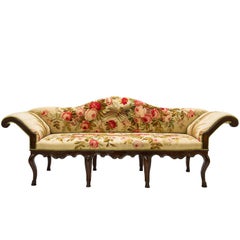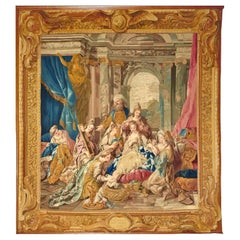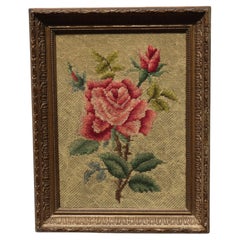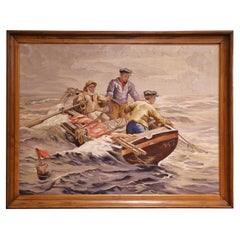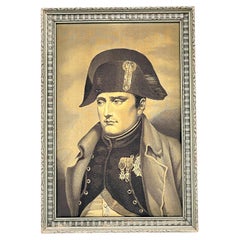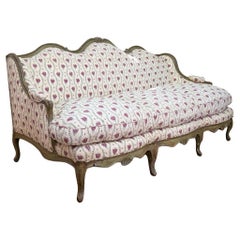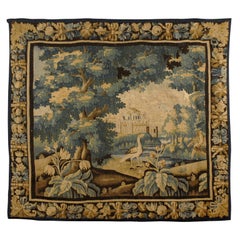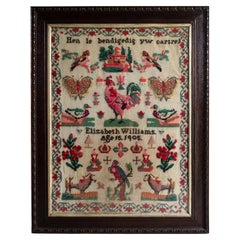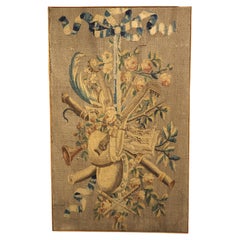Carved Tapestries
to
3
12
3
12
3
Height
to
Width
to
1
1
1
1
1
1
1
6
1
5
3
2
3
1
1
12
10
3
3
3
11
7
4
3
3
15
15
15
3
3
1
1
Technique: Carved
English Victorian Floral Framed Embroidery
Located in Queens, NY
English Victorian carved rectangular gold floral embroidery on black background with oak and ebonized carved frame
Category
Late 19th Century British Victorian Antique Carved Tapestries
Materials
Oak
Sofa Louis XV, Covered with Authentic Perfect Aubusson Tapestry
Located in Alessandria, Piemonte
1910/M,
I hope You can understand what it is from some photos only.
Museum quality antique sofa, coating with an authentic Aubusson old tapestry: every...
Category
Late 18th Century Italian Louis XV Antique Carved Tapestries
Materials
Wood
Tapestry Royal Manufacture of Aubusson, Louis XVI period 1738 at the Gobelins
Located in Madrid, ES
Tapestry from the Royal Manufacture of Aubusson, Louis XVI period , made in 1738 at the Gobelins
One panel from a series of Gobelins tapestries depicting the History of Esther, illustrating Esther seated and attended by handmaidens, one washing her feet in golden basin, another fastening a bracelet, another offering a mirror, all observed by Mordecai, woven in the workshop of Michele Audran after a design by J. F. de Troy.
The Toilet of Esther c.1778-85.Royal Collection Trust-Queens Audience Chamber
Windsor Castle
The Sketches for the Esther Cycle by Jean-François de Troy (1736)
“and the maid was fair and beautiful; whom Mor’decai, ..., took for his own daughter.” (Est. 2:7)
A supple and undulating genius, both a flattering portraitist and a prolix history painter, as well as a brilliant genre painter, in a gallant or worldly vein, Jean-François de Troy (Paris, 1679 – Rome, 1752), solicited, although he had passed the threshold of old age, a new royal commission up to his ambitions. To obtain it, he submitted – successfully - for the approval of the Bâtiments du roi (administration), seven modelli painted in 1736 with his usual alacrity.
Inspired by one of the most novelistic texts of the Old Testament, the Book of Esther, these sketches in a rapid and virtuoso manner were transformed by the artist, between 1737 and 1740 into large cartoons intended to serve as models for the weavers of the Gobelins factory. Showing undeniable ease and skill in the composition in perfect harmony with the sensitivities of the times, the tapestry set met with great success.
The Story of Esther perfectly corresponded to the plan of the Bâtiments du roi to renew the repertoire of tapestry models used for the weavers of the royal factories while it also conformed to the tastes of Louis XV’s subjects for a fantastical Orient, the set for a dramatic tale in which splendour, love and death were combined. Indeed, no tapestry set was woven in France during the 18th century as often as that of Esther.
The series of modelli painted by de Troy during the year 1736 looks to the history of French painting and decoration under Louis XV as much as it does the history of the Gobelins. It probably counts among the most important rococo pictorial groups to have remained in private hands. First the Biblical source illustrated by De Troy which constitutes the base of one of the richest iconographical traditions of Western art will be considered. Then the circumstances and specific character of French civilisation during the reigns of Louis XIV and Louis XV which contributed to making the theme of Esther a relevant subject, both attractive to contemporaries and remarkably in line with the sensitivities of the time will be elucidated.
An examination of the exceptional series of sketches united here, the cartoons and the tapestries that they anticipate as well as a study of their reception will close this essay. The Book of Esther: A scriptural source at the source of rich iconography.
The origin of the Esther tapestry set by Jean-François de Troy – origin and creation of a masterpiece
According to the evidence of one of the artist’s early biographers, the chevalier de Valory, author of a posthumous elegy of the master, read at the Académie royale de peinture et de sculpture on 6 February 1762, it was apparently due to early16 rivalry with François Lemoyne (1688-1737), his younger colleague who had precisely just been appointed First Painter to the King in 1736, that had encouraged François de Troy to seek a commission allowing him to show off his ease and his promptitude at the expense of a rival who was notoriously laborious: “M. De Troy, retaining some resentment of the kind of disadvantage which he believed to have suffered compared with his emulator looked to regain some territory by making use of the facility his rival did not possess.
Lemoyne was excessively long in the creation of his works,and M. De Troy of a rare celerity: consequently, with this particular talent, the latter offered to the court to make paintings appropriate to be executed at the Gobelins Factory; and it is to this circumstance that we owe the beautiful series of the Story of Esther, which would be sufficient alone to give him a great reputation.”17 Beyond the suspicion inspired by the topos, which still constitutes, more or less, a tale of rivalries between artists in ancient literature, there is probably some truth in what Valory reports although A.-J. Dezalier d’Argenville (who indicates rather spitefully that de Troy did not hesitate to “cut prices” to impose himself, benefitting from the productivity assured by the unlikely rapidity of his brush)18 proves to be more evasive: “As he looked to busy himself, he had offered to make the paintings that serve as models for the King’s tapestries cheaply: which did not please his colleagues.
He was given a choice of two tapestry series to be made and he took the Story of Esther and that of Jason”.19 Whether or not the choice was actually left to de Troy (which would appear rather casual on the royal administration’s part all the same), it seems likely that the artist, whose contemporaries extol his “fire”, as the faculty of invention was then called, must have ardently aspired to the possibility of using on a very large scale the “creative genius” with which Dezallier d’Argenville credits him. The decoration of the private apartments, the fashion for which Louis XV had promoted at Versailles and Fontainebleau, offered little opportunity to excel in this area. Other than painting for altarpieces, only tapestries could allow comparison with Lemoyne who had been granted – unfortunately for him – a major decoration: the enormous ceiling of the Hercules Room at Versailles. Favoured by the recent improvement in France’s financial situation, the revival of patronage offered de Troy a commission fitting for him, in a field in which, however, he had hardly any experience.
Anxious to renew the repertoire of models available to the Gobelins factory, the Duc d’Antin, surintendant des Bâtiments du roi from 1708 to 1736 followed by his successor, Philibert Orry comte de Vignory, gave him the task of producing seven large cartoons inspired by the Book of Esther corresponding to the brilliant sketches or modelli which de Troy had produced in one go, or almost (very few preparatory drawings can in fact be linked to the Esther cycle and all seem to be at the execution stage of the cartoons).20 Subjected to the approval of the Administration des Bâtiments according to the procedure in use for projects being planned for the Gobelins, sketches made rapidly during 1736 were approved and the project launched immediately. Thereupon came the news of François Lemoyne’s death, who, ground down by work and a victim of his private torment, committed suicide on 4 June 1737.
Against all expectations, de Troy did not replace his rival in the position of First Painter (which remained vacant until the appointment of Charles Coypel in January 1747), which would perhaps have made him too obviously the beneficiary of the drama. The awarding of the position of Director of the French Academy in Rome came to console him while he had already produced (or he was in the process of finishing), in Paris, three of the seven cartoons of the cycle (The Fainting of Esther finished in 1737 and the Toilet and Coronation of Esther, both finished in 1738).
De Troy, we can see, did not follow the order of the narrative but began with the subjects which apparently offered the least difficulty because he had already depicted them, or because they fall into a strong pictorial tradition (such is the case especially for the Fainting of Esther). He had hardly settled at the Palazzo Mancini in August 1738, when his first task which awaited the new director of the French Academy naturally consisted of honouring the royal commission and finishing without delay the final cartoons of the Story of Esther after the sketches he must have taken with him. As prompt as ever, de Troy discharged himself of the execution of the four remaining cartoons in only two years, by beginning with the largest format which allowed him to strike the imagination and to impose himself as soon as he arrived on the Roman stage: the Triumph of Mor’decai which was finished in 1739 (like Esther’s Banquet).
The following year, the Mor’decai's Disdain and The Sentencing of Haman were brought to an end in the same Neo-Venetian style, obviously tributary to Veronese with its choice of “open” monumental architecture which is characteristic of the entire cycle.21 The series, it should be noted, was almost augmented with some additional scenes in the mid 1740s. Indeed, the first tapestry set finished at the Gobelins in 1744 proved to be unsuitable for the arrangement of the Dauphine’s apartments at Versailles for which it had been intended to decorate the walls the following year (cf infra). Informed of this, de Troy, considering that the story of Esther offered “several good subjects,” immediately offered to illustrate one or new subject among those “which could appear to be the most interesting”.
The directeur des Bâtiments Orry, who managed the State’s accounts, obviously judged it less costly to have one of the tapestries widened to fill in the end of the Dauphine’s bedroom,22 which has probably deprived us of very original compositions, because de Troy had already illustrated the most famous themes, those that benefitted from a strongly established iconographical tradition and from which it was not easy to deviate
The Tapestry Set of the Story of Esther
Placed on the tapestry looms of the Gobelins at the end of the 1730s in Michel Audran’s workshop, the cycle created by de Troy aroused true infatuation. The few hundred tapestries made between 1738 and 1797 – all in high-warp tapestry and woven in wool and silk except for four in low-warp made in Neilson’s workshop – show the impressive success of a tapestry set that was without any doubt the most frequently woven of the 18th century in France.
29 Only three cartoons had been delivered by de Troy in 1738 when the first tapestry set was begun by Audran under the expert eye of Jean-Baptiste Oudry to whom the Directeur général des bâtiments, Philibert Orry had assigned the (weekly) supervision of the weaving. During the summer of 1738, the piece of the Fainting of Esther, which Oudry judged to be admirable, was finished.
During the winter of 1742, Oudry informed Orry that about two ells of the Triumph of Mor’decai had been made “with no faults”,that the Coronation of Esther was finished and that the Esther at her Toilet “a very gracious tapestry” was “a little over half” finished. Exhibited at Versailles in 1743, these two last pieces were admired by Louis XV and the Court.
On 3 December 1744, the set of seven tapestries was finally delivered to the Garde Meuble. It was intended, the honour was not slight, to decorate the apartments of the Infanta Maria Teresa Rafaela of Spain whose marriage to the young Dauphin Louis-Ferdinand had been fixed for the following year (it took place on 23 February 1745). Apparently it was thought that the theme of Esther the biblical heroine and wife of a foreign sovereign was appropriate for the apartments of the Spanish Dauphine.
As early as the month of March, the architect Ange-Jacques Gabriel informed de Troy that her grand cabinet was decorated with the “Esther tapestry set” specifying however that “for lack of two small or one large piece, we have not been able to decorate the end of the room”. This difficulty led immediately to the Banquet episode being woven a second time in two parts (they were delivered to the Garde-Meuble on 30 December 1746) to garnish the panels on each side of the bed of the Dauphine who would hardly enjoy them (she died on 22 July 1746 and the decoration was installed for the new Dauphine Maria Josepha of Saxony).
The appearance of the set’s remarkable border, which imitated a richly sculpted wooden frame, should be mentioned. Conceived in 1738 by the ornamentalist Pierre Josse-Perrot and used in the later weavings until 1768, it tended to reinforce the resolutely painterly appearance of the tapestry set which, in this regard, pushed the art of tapestry as far as its ultimate mimetic possibilities. With the exception of Mor’decai's Disdain which had been removed earlier, the “editio princeps” of the story of Esther (from then on in nine pieces) remained at Versailles until the Revolution. Of the eight surviving tapestries, four are at the chateau of Compiègne and four belong today to the Mobilier National. No less than seven tapestry sets reputed to be complete (one of them in fact only had six tapestries) would be produced officially at the Gobelins up to 1772.
Literature:
1- The Œuvres mêlées of an emulator of Racine, the Abbé Augustin NADAL thus include an Esther. Divertissement spiritual which is exactly contemporary with Jean François de Troy’s cycle since it was performed in 1735 and published in Paris three years later.
2-Le Siècle de Louis XIV, 1751, 1785 ed., p. 96-97 for French ed.
3- Lemoyne and de Troy had been obliged to share the First Prize in the competition organised in 1727 between the most prominent history painters of the Académie Royale.
4- Mémoires…, pub. L. DUSSIEUX et al., 1854, II, p.265.
5-The fact that de Troy, at the risk of falling out with his colleagues, did not hesitate to make use of prices in order to convince the new directeur des Bâtiments Philibert Orry, is confirmed by Mariette who adds tersely “it caused much shouting” (pub. 1851-1860, II, p. 103).
6- Abrégé de la vie des plus fameux peintres…, ed. 1762, IV, p. 368-369 20 Early comments on the painter are inclined to present him as a kind of “pure painter”, doing without the medium of drawing, a few intermediary studies between the Esther sketches and the large cartoons at the Louvre nevertheless show that de Troy used red chalk (see in the catalogue, the notice for the Meal of Esther and Ahasuerus under the entry drawing) to change one or other figure.
7-C. GASTINEL-COURAL (cat. exp. PARIS, 1985, p. 9-13) as well as the article by J. VITTET, exh. cat. LA ROCHE-GUYON, 2001, p. 51-55.
8-The Hermitage in St. Petersburg conserves five tapestries of these two royal gifts whose provenance still awaits elucidation (as far as we are aware). In 1766, the Grand Marshal of Russia, Count Razumovski (or Razamowski), acquired the Fainting and the Banquet extracted from the sixth weaving (J. VITTET, 2001, p. 53).
9- Lettres écrites de Suisse, d’Italie…,quoted by J. VITTET, op. cit., p. 54.
10-The tapestry set remained in the hands of a branch of the Hapsburg-Lorraine family until 1933 (ibid. P. 54).
11-Quoted by Chr. LERIBAULT, 2002, p. 97, note 269.
12-Y. CANTAREL-BESSON, 1992, p. 241.
Catalogue
The Esther at her Toilet
Oil on canvas, 57 x 51 cm Provenance: Painted in 1736 at the same time as the six other modelli of the Story of Esther intended to be presented, for approval, to the direction des Bâtiments du Roi; perhaps identifiable among a lot of sketches by Jean-François de Troy in the post mortem inventory of the amateur, historian and critic Claude-Henri Watelet (1718-1786) drawn up on 13 January 1786 and following days (A.N. T 978, n° 30) then in the sale of the property of the deceased, Paris, 12 June 1786, n° 33; Paris, François Marcille Collection (who owned a series of six sketches from which the Triumph of Mor’decai was missing, see infra); Paris, Marcille Sale, Hôtel Drouot, 12-13 January 1857, n° 36; Asnières, Mme de Chavanne de Palmassy ( ?) collection; Paris, Galerie Cailleux; Paris, Humbert de Wendel collection (acquired from the Galerie Cailleux in 1928); by inheritance in the same family; Paris, Sotheby’s, 23 June 2011, n° 61. In order not to add unnecessarily to the technical commentary on each work, the catalogue raisonné by Chr. Leribault which contains a substantial bibliography on the series should be referred to. The other bibliographical references only concern the publications and exhibitions to have appeared and been presented more recently. Bibliography and Exhibitions: Chr. LERIBAULT, 2002, n° P. 247 (repr.); E. LIMARDO DATURI, 2004, p. 28; Exh. cat. NANTES, 2011, p. 138, n° 34, referred to in note 1; Sotheby’s catalogue, Tableaux anciens et du XIXe siècle, 23 June 2011, n° 61 (repr.).
Related Works:
Tapestry cartoon: The cartoon (oil on canvas, 329 x 320 cm), the third made by the artist in Paris after the sketches had been approved by the direction des Bâtiments, is in the Louvre (Inv. 8315). It previously bore the painter’s signature and the date 1738 (inscriptions which are found on the tapestries). The royal administration paid 1600 livres for it on 21 June 1738 and it was exhibited at the Salon in the year of its creation.
Summary Biography
1679 (27 January): Baptism in Paris (Parish of St. Nicolas du Chardonnet) of Jean-François de Troy, son of the painter François de Troy and Jeanne Cotelle, sister of the painter Jean II Cotelle.
1696-1698: Studies (apparently rather turbulent) at the Académie royale de peinture et de sculpture.
1698-1708: First trip to Italy. Is obliged to leave Rome in January 1711 after a tempestuous affair (a duel?), de Troy extends the traditional Roman experience as a pensionnaire at the Académie de France by also visiting Tuscany where he stays for a long time, Venice (his art in face has a strongly Venetian character) and Genoa.
1708: De Troy (whose father had been elected Director of the Académie royale de peinture et de sculpture on 7 July) is agréé and immediately received at the Académie with Apollo and Diana Piercing with their Arrows the Children of Niobe (Montpellier, Musée Fabre) on 28 July.
1710: First royal commission, paid for on 10 May (a sketch representing “the Promotion of the Order of the Holy Spirit” for the tapestry series of the History of the King).
1716: Jean-François de Troy is elected Assistant Professor at the Academy.
1720: He is appointed Professor.
1723: The artist creates the double portrait of Louis XV...
Category
Early 18th Century French Baroque Antique Carved Tapestries
Materials
Wool, Silk
Vintage Embroidered Picture "Beautiful Rose" in a Golden Frame
Located in Bussiere Dunoise, Nouvel Aquitaine
French Vintage Embroidered Picture "Beautiful Rose" in a Golden Frame from the Mid-Century.
This lovely artwork features a stunning hand-embroidered rose motif in soft colors, set w...
Category
1950s French Folk Art Vintage Carved Tapestries
Materials
Metal
$152 Sale Price
35% Off
Early 20th Century French Aubusson Nautical Hand Woven Tapestry in Oak Frame
Located in Dallas, TX
This early 20th-century French hand-woven tapestry, crafted circa 1920, depicts a dramatic maritime scene of three fishermen navigating choppy waters as they cast their nets from a s...
Category
Early 20th Century French Carved Tapestries
Materials
Canvas, Oak
French Grisaille (Grey) Tapestry Portrait of Napoleon Bicorne Hat & Greatcoat
Located in West Palm Beach, FL
French Grisaille (Grey) Tapestry Portrait of Napoleon Bicorne Hat and Greatcoat
France, circa 1920s
Capture a piece of French history with this exquisite Grisaille (Grey) Tapestry ...
Category
Early 20th Century French Empire Carved Tapestries
Materials
Fabric, Wood
$592 Sale Price
33% Off
18th Century French Aubusson Tapestry Fragment in Carved Gilt Frame
Located in Dallas, TX
Decorate a wall with this colorful 18th-century Aubusson tapestry fragment. Hand woven in France circa 1750, the tapestry depicts a richly woven bird nestled amid a lush arrangement ...
Category
Mid-18th Century French Antique Carved Tapestries
Materials
Tapestry, Giltwood
Framed Thai Painted Silk Tapestry
Located in Chicago, IL
Hand painted black silk tapestry of twin Thai Buddhist goddess Parvati. Framed in a double faux bamboo frame in black lacquer and parcel gilt with a gras...
Category
1960s Thai Vintage Carved Tapestries
Materials
Grasscloth
18th Century Italian Mecca Hand-Carved Tassels on an Antique Braid
By Interi
Located in Dublin, Dalkey
18th century Italian hand-carved mecca tassels strung on an antique braid. The tassels originally came from an Italian church in Tuscany and were used during feast days. The braiding...
Category
18th Century Italian Rococo Antique Carved Tapestries
Materials
Metal, Silver Leaf
Pair of Monumental English Regency Framed Italian 18C Painted Tapestries
Located in Dallas, TX
PRESENTING an EXCEPTIONAL Pair of Monumental English Regency Framed Italian 18C Painted Tapestries/Paintings.
We are of the firm opinion, that these tapestries were made and hand-pa...
Category
Late 18th Century Italian Grand Tour Antique Carved Tapestries
Materials
Burlap, Mahogany
$26,000 Sale Price / set
46% Off
Modern Light Blue Silver Abstract Chenille Rug Without Fringe Ready to Ship
Located in New York, NY
The Rapture Collection is a high-end rug collection that includes 29 rug design options, in 155 design and rug color combinations, totaling 620 various design-color-size combinations...
Category
2010s Turkish Post-Modern Carved Tapestries
Materials
Chenille
Modern Moroccan Berber Style Black and Silver Abstract Rug in Stock
Located in New York, NY
The Rapture Collection is a high-end rug collection that includes 29 rug design options, in 155 design and rug color combinations, totaling 620 various design-color-size combinations. The rugs perform well in residential interior, hospitality interior, and offset commercial interior settings. Woven Concepts specializes in the creation of high end, contemporary, high quality and high performance rugs.
Size Tolerance: due to the hand-made nature of this product, the rug size is approximate, and the width and length may vary plus or minus a few inches from the listing rug size indicated.
- (Merit) beige - Black silver rug...
Category
2010s Turkish Post-Modern Carved Tapestries
Materials
Chenille
18th C. French Aubusson Tapestry in Oak Frame Depicting Louis XIII and Richelieu
Located in Dallas, TX
This elegant antique tapestry was woven in Aubusson, France circa 1780, and was likely created as part of a larger wall boiseries paneling ensemble. Set in its original carved oak frame with recessed decorative corners, the large handwoven textile depicts King Louis XIII of France in discussion with his powerful prime minister, Cardinal Richelieu...
Category
Late 18th Century French Louis XIII Antique Carved Tapestries
Materials
Tapestry, Oak
Modern Chevron Dark Brown and Charcoal Chenille Area Rug Ready to Ship
Located in New York, NY
The Rapture Collection is a high-end rug collection that includes 29 rug design options, in 155 design and rug color combinations, totaling 620 various design-color-size combinations...
Category
2010s Turkish Post-Modern Carved Tapestries
Materials
Chenille
Set of Three French Aubusson Portiere Tapestries with Allegorical Scenes
Located in Dallas, TX
Decorate a living room, hallway, or grand staircase with this elegant set of three tall woven portières. Handwoven in Aubusson, France circa 1970, each wall hanging features allegori...
Category
Mid-20th Century French Neoclassical Carved Tapestries
Materials
Tapestry, Canvas, Giltwood
Related Items
Louis XV period Canapé à Oreilles Serpentine Shaped Sofa, Settee Upholstered
Located in Basingstoke, Hampshire
A Louis XV period Canapé à Oreilles serpentine-shaped sofa. Featuring carved detailing, decorated with floral motifs and acanthus, with original Verd...
Category
18th Century French Louis XV Antique Carved Tapestries
Materials
Walnut
$15,279
H 39.38 in W 77.56 in D 41.34 in
French Regence Period Aubusson Tapestry with Landscape Scene, c. 1720
Located in Atlanta, GA
A fine and very large Aubusson tapestry, featuring a central Landscape scene elaborately depicting with exotic birds in the foreground, and a country home. The border with intertwine...
Category
Early 18th Century French Régence Antique Carved Tapestries
Materials
Wool
18th Century French Aubusson Tapestry
Located in Gloucestershire, GB
A large 18th Century French Aubusson verdure tapestry.
Lots of lush, verdant foliage frames the view on to castle ruins.
The tapestry is in good condition, with all its borders intac...
Category
1780s French Antique Carved Tapestries
Materials
Tapestry
Hand Carved, Louis XV Style Sofa Made By La Maison London
Located in London, Park Royal
Louis XV style, hand-carved, curved back, freestanding, sofa. Hand finished in antique white and lightly distressed. Upholstered in a Lelievre, damask, fabric with deep filled, feath...
Category
2010s British Louis XV Carved Tapestries
Materials
Hardwood
Large Chinese Silk Embroidery, Framed
Located in Bradenton, FL
This tall Chinese silk embroidery depicts Asian figures and scenes of boats, bridges and Asian landscapes. Features red, green, salmon and whit...
Category
19th Century Chinese Chinese Export Antique Carved Tapestries
Materials
Silk
19th Century French Aubusson Tapestry
Located in New York, NY
Handwoven in Aubusson, France in the 19th Century, this lovely Tapestry features a pair of lovers in a classic Rococo vinyet and has its original fruit and floral border. It measures...
Category
Mid-19th Century French Aubusson Antique Carved Tapestries
Materials
Tapestry, Wool, Silk
Louis XV Style Carved Walnut Sofa with Cream Damask Upholstery
Located in Atlanta, GA
This elegant Louis XV style sofa features a hand carved walnut frame with graceful curves, floral accents, and a deep serpentine front, true to the Rococo spirit of 18th-century Fren...
Category
20th Century French Louis XV Carved Tapestries
Materials
Walnut
Framed Antique Chinese Embroidery Panel Qing Dynasty Provenance
Located in Atlanta, GA
An antique Chinese embroidery panel, originally the sleeve band of a robe from Qing Dynasty, circa 19th century. Nicely presented as a...
Category
Mid-19th Century Chinese Chinese Export Antique Carved Tapestries
Materials
Silk, Wood
18th Century Louis XV Period Walnut Sofa with Floral Carvings and Tapestry Uphol
Located in Atlanta, GA
An elegant Louis XV period three-seat sofa from the Rhône Valley, beautifully crafted in solid walnut with graceful proportions and richly hand-carved details. The serpentine backres...
Category
18th Century French Louis XV Antique Carved Tapestries
Materials
Walnut
$3,950
H 40 in W 76 in D 29.75 in
Framed Antique Japanese Silk Embroidery Fukusa Textile Panel
Located in Atlanta, GA
A Japanese Fukusa Panel with tassels displayed in a gilt frame circa Meiji Period. Fukusa is a traditional Japanese textile art used as a...
Category
Late 19th Century Japanese Meiji Antique Carved Tapestries
Materials
Silk, Wood
18th Century French Louis XV Walnut Sofa
Located in London, Park Royal
Sofa in Walnut,molded and sculpted backrest with triple convolution,recessed armrests,resting on eight arched serpentine legs.
of the Louis XV Period.
We can re cover the Sofa upon r...
Category
Late 18th Century French Louis XV Antique Carved Tapestries
Materials
Upholstery, Walnut
Maison Jansen Stamped Sofa, Louis XV Style, France
Located in Montreal, Quebec
Rare Maison Jansen stamped French Louis XV style sofa with original grey patina, and clean lined cream upholstery. Lovely classical Louis XV shape, good width, seats three comfortabl...
Category
1940s French Louis XV Vintage Carved Tapestries
Materials
Wood
Previously Available Items
Large Antique Welsh Folk Art Needlework Sampler, Carmarthenshire 1905
Located in Bristol, GB
ANTIQUE FRAMED EDWARDIAN SAMPLER
An unusually large-scale and impressive pictorial sampler which depicts a wealth of animals and symbols within a strawberry border.
Also, it is unusual to have the Welsh language inscription, which reads ‘Hen le bendigedig yw cartref’, although Google Translate translates this as ‘Home is a wonderful old place’, the most common translation seems to be ‘Home sweet home’, but we have also had an in-person translation to ‘Our home is a splendid place’.
The sampler is signed ‘Elizabeth Williams...
Category
Early 20th Century Welsh Folk Art Carved Tapestries
Materials
Wool, Cotton, Glass, Wood
H 38.59 in W 30.32 in D 0.79 in
A Framed 18th Century Aubusson Musical Trophy Tapestry Fragment, Circa 1785
Located in Dallas, TX
More information coming soon…
Originally part of a larger Aubusson tapestry from circa 1785, this fragment depicts a musical trophy on a gray background. The assorted instruments a...
Category
Late 18th Century French Antique Carved Tapestries
Materials
Textile, Tapestry, Wood
H 62.125 in W 38.5 in D 1.5 in
Contemporary Woolen Art Work - Abstract Woolen Wall Object
Located in Bussiere Dunoise, Nouvel Aquitaine
Handmade Wool Artwork made by M. Dombrowsky.
An abstract, minimalist work made of wool and wood
Each work is handcrafted, dyed, and spun by hand.
The wool is intricately wrapped, ...
Category
2010s French Minimalist Carved Tapestries
Materials
Wool, Reclaimed Wood
Pair of Silk Velvet Fragments w/ Silver Thread, Probably Florence Italy, c 1600
Located in Milford, NH
Two panels of forest green cut silk velvet with silver metal thread from Florence Italy, circa 1600-1650 with a very large floral motif rising up out of an urn. Both mounted separate...
Category
Early 17th Century Italian Baroque Antique Carved Tapestries
Materials
Silk, Velvet, Wood
H 68.5 in W 20.75 in D 1.5 in
Pair of Mid-Century French Hand Woven Verdure Tapestries w/ Bird & Foliage Motif
Located in Dallas, TX
Decorate a living room, den or study with this elegant and colorful pair of tapestries. Handwoven in France, circa 1970, each verdure wall piece has its original fruit and floral bor...
Category
Mid-20th Century French Carved Tapestries
Materials
Tapestry, Canvas, Giltwood
H 84 in W 57.5 in D 0.25 in
Antique Tapestry Oil Painting of Young Girl, Framed, Circa 1900
Located in Big Flats, NY
An antique oil painting on tapestry depicts young girl with hat in flower meadow setting, framed, c1900.
Measures: 48" H x 32" W x 1.5" D.
Category
Early 20th Century Carved Tapestries
Materials
Tapestry, Glass, Wood
Antique Tapestry Oil Painting of Young Lady, Circa 1900
Located in Big Flats, NY
An antique oil painting on tapestry depicts young lady in countryside setting with stream, framed, c1900.
Measures: 43.5" H x 27.75" W, canvas sight: 42.75" x 27.25".
Category
Early 20th Century European Victorian Carved Tapestries
Materials
Tapestry, Wood
Antique Oversized Framed Tapestry Painting of Young Woman & Fruit, c 1900
Located in Big Flats, NY
A large antique tapestry painting depicts young woman with fruit in countryside setting, seated in parcel gilt frame having foliate, floral and shell ...
Category
Early 20th Century French Carved Tapestries
Materials
Tapestry, Glass, Wood
19th Century French Louis XIII Carved Walnut and Tapestry Fireplace Screen
Located in Dallas, TX
Place this elegant and colorful antique screen in front of your mantel! Created in France, circa 1870, the freestanding guard features a removable handwoven tapestry with a gentleman...
Category
Late 19th Century French Louis XIII Antique Carved Tapestries
Materials
Tapestry, Walnut
Fine 17th Century Barley or Solomonic Twist Baroque Walnut Stool with Tapestry
Located in Oxfordshire, United Kingdom
Dating from the last quarter of the 17th century and with a period tapestry fragment cover, this walnut stool certainly has a presence.
Raised on the original solid walnut bun fe...
Category
17th Century English Baroque Antique Carved Tapestries
Materials
Walnut
H 16.15 in W 17.72 in D 15.36 in
Lawn Tennis Diptych Hand Stitched Canvas, Framed on Cherrywood
By Casey Waterman
Located in Miami Beach, FL
Handstitched canvas, thread. Wood cherry frame
Each artwork dimension is 20 in. H x 16 in. W
One of a kind
Casey Waterman was born and raised in a small rural town in New Hampsh...
Category
2010s American Modern Carved Tapestries
Materials
Canvas, Thread, Wood
Swing, Hand Stitched Canvas, Cherrywood Frame
By Casey Waterman
Located in Miami Beach, FL
Hand stitched canvas, thread. Wood cherry frame
Dimensions: 20 in. H X 16 in. W
One of a kind
Casey Waterman was born and raised in a small rural ...
Category
2010s American Modern Carved Tapestries
Materials
Canvas, Thread, Wood
Recently Viewed
View AllMore Ways To Browse
Organ Used
Ornate Fireplace Screen
Outdoor French Garden Table
Outdoor Saddle Swing
Painted Demilune Commode
Painted Four Poster Bed
Painted Highboys
Painted Kitchen Hutch
Painted Wooden Drawers
Pair Of Louis Philippe Commodes
Pandan Box
Parrot Figurine
Paul Evans Mid Century Modern Bed
Paul Mccobb Gentlemans Chest
Paul Smith Stripes
Paul Stanley
Peacock Carving
Pedestal Swan
